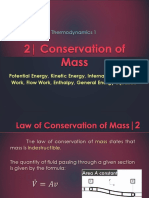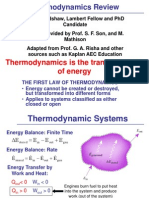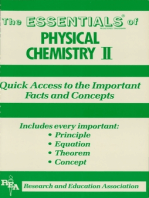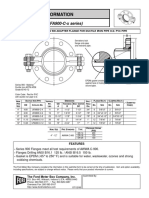Applied Lecture 01 Solved PDF
Uploaded by
Jessica GarrettApplied Lecture 01 Solved PDF
Uploaded by
Jessica GarrettAPPLIED LECTURE 1 - SOLUTIONS
Exercise 1
A reciprocating compressor is a compressor that exploits a piston driven by a crankshaft so as to
deliver gases at relatively high pressure. The reciprocating compressor normally displays
automatic valves.
We can represent the cycle of the compressor in the p-V diagram:
Where:
p
e
= environment pressure
p
t
= tank pressure
At point 4 the piston is at its top dead center position and highlights the minimum chamber
volume i.e. the clearance volume V
o
. As the piston begins to move downward the in-cylinder
pressure decreases and the discharge valve closes under a differential pressure. Expansion
occurs next as the small volume of gas in the clearance pocket is expanded to pressure p
1
. When
the pressure reaches the value of p
1
the intake valve opens allowing fresh charge to enter the
cylinder (intake stroke). The piston keeps moving downward during the suction stroke as far as
its bottom dead center position (point 2). Compression then takes place as the intake valve
automatically closes. At point 3 the discharge valve opens and the piston movement causes the
discharge of the compressed gases.
We choose to solve the problem using a Lagrangian approach for closed systems. The system
consists of the total mass that fills the cylinder volume at the end of the intake stroke (2)
The system is highlighted with a dashed line and results from the sum of mass m
1
and mass m
e
.
So as to determine the air admitted in the compressor cylinder during the intake stroke, let us
consider the following masses:
m
e
= air mass admitted in the cylinder;
m
1
= air mass inside the cylinder at the beginning of the intake stroke;
m
2
= air mass inside the cylinder at the end of the intake stroke (
e 1 2
m m m + = ).
The first thermodynamic law applied to the total mass m
2
from the beginning of the intake
stroke (time t
1
) to the end of the intake stroke (time t
2
) states:
E Q L = +
Work transfer interaction
The work transfer interactions take place for boundary displacements that is over the piston
surface and on the hypothetical boundary surrounding the air mass to be admitted in the
cylinder. On the surface of the ideal boundary embracing the sucked air mass the pressure is
constant at value p
e
. On the piston head surface we can assume a constant pressure p
1
(pressure
of the cylinder at beginning and at the end of the intake stroke).
The work received by the system is:
( ) ( )
1 1 2 1 e e 1 2 1 e1 e2 e
t2
t1
1
t2
t1
e
t2
t1
j j
V p V p V p V V p V V p dV p dV p dV p L + = = = =
Energy system variation during the transformation
The energy system variation results from the sum of the internal energy variation, kinetic energy
variation, gravitational potential energy variation and the variation of energy storage from
centrifugal forces:
E E E U E
g c
+ + + =
0 E
c
as we consider a nil velocity at the start and at the end of the process;
0 E
g
negligible with respect to the other energy changes when a gas is considered;
0 E
as we consider an inertial frame of reference.
The overall energy variation is hence given by the internal energy variation. We can evaluate
this latter considering the masses and the related specific internal energy (u):
i i i
u m U =
( )
e e 1 1 2 2
u m u m u m U + =
Calculation of the amount of air mass sucked by the compressor
We can replace the work and the internal energy expressions inside the first thermodynamic
law:
( )
e e 1 1 2 2 1 1 2 2 e e
u m u m u m Q V p V p V p + = + +
( ) ( )
e e e e 1 1 1 1 2 2 2 2
V p u m V p u m V p u m Q + + + =
Considering the specific volume (v):
i i i
v m V = :
( ) ( ) ( )
e e e e 1 1 1 1 2 2 2 2
v p u m v p u m v p u m Q + + + =
Considering the enthalpy (h):
i i i i
v p u h + = :
e e 1 1 2 2
i m i m i m Q =
e p e 1 p 1 2 p 2
T c m T c m T c m Q =
Considering the ideal gas law mRT pV = :
e e
1 1 2 2
e e 1 1 2 2
p
T m
R
V p
R
V p
T m T m T m
c
Q
= =
Remembering that
2 1
p p = :
( ) kg 10 1.466
T c
Q
V V
RT
p
m
3
e p
1 2
e
2
e
= =
Calculation of the in-cylinder temperature at the end of the intake stroke
Using again the ideal gas law we obtain:
kg 10 3.283
RT
V p
m
4
1
1 1
1
= =
kg 10 1.794 m m m
3
e 1 2
= + =
K 304.4
R m
V p
T
2
2 2
2
= =
Proposed Exercise 2
V
We can write the energy conservation equation for non-stationary flows (Eulerian approach).
The dashed line identifies the control volume.
f i
E
t
E
L Q
& & &
+
= +
Where:
0 Q =
&
we assume the process to be reversible and adiabatic (isentropic)
0 L
i
=
&
work interactions are nil due to the absence of shafts inside the volume
The mass conservation equation states:
0 m
t
m
f
= +
&
Where
f
m& accounts for the mass flow rate trough the ports:
0 m m
t
m
in out
= + +
& &
The system simply displays an outlet port:
0 m
t
m
out
= +
&
If we consider a one-dimensional flow we can use the total derivative:
out out
-dm dt m - dm = = &
Remembering the energy conservation law:
0 E E
t
E
E
t
E
f,in out f, f
= +
= +
& & &
Where 0 E
f,in
=
&
. We can write:
0 e m
t
E
out f,
= +
&
Where e
f,out
is the specific energy.
If we consider a one-dimensional flow we can use the total derivative:
0 dt e m dE
ou f, out
= + &
dm e dE
out f,
=
We refer to the evolution from time t
1
(beginning of the outflow) to time t
2
(end of the outflow
i.e. the pressure in the canister equals the environment pressure):
=
t2
t1
out f,
t2
t1
dm e dE
1 1 2 2
t2
t1
e m e m dE =
gz
2
c
u e
2
+ + =
0 gz when a gas is considered
0
2
c
2
kinetic energy is negligible at the beginning and at the end of the process
We can write the first integral:
1 1 2 2
t2
t1
u m u m dE =
From the definition of the e
f
:
gz
2
c
h e
2
f
+ + =
We can write the second integral:
+ =
+ =
t2
t1
t2
t1
2
out
out p
t2
t1
2
out
out
t2
t1
out f,
dm
2
c
dm T c dm
2
c
h dm e
We can rewrite the equation:
+ =
t2
t1
t2
t1
2
out
out p 1 1 2 2
dm
2
c
dm T c u m u m
=
t2
t1
t2
t1
out
2
out
out p 1 v 1 2 v 2
dm
2
c
- dm T c T c m T c m
According to the perfect gas law and neglecting the volume of the nozzle, the mass filling the
canister at the beginning of the process is:
kg .307 1
RT
V p
m
1
1 1
1
= =
The specific heat at constant volume is:
v p
c c R 717.5 J/kgK = =
As the gas expands isentropically:
constant
p
p
T
T
k
1 k
1
2
1
2
=
=
K 302.73 T
2
=
Hence the maximum turbine work is:
out p 2 out p 1 1 v 1 2 v 2
t2
t1
out
2
out
T c m T c m T c m T c m dm
2
c
+ =
The integral in the equation represents the maximum work in case all the kinetic energy of the
out flowing mass is converted into work.
kJ 362.7 dm
2
c
t2
t1
out
2
out
=
Proposed exercise 3
pi
Ti
Vi
p1
T1
V
We can solve the problem using a Lagrangian approach for closed systems:
E L Q = +
The dashed line highlights the boundaries of the system (mass m
1
+m
i
) at the beginning of the
process. We consider the evolution from the opening of the valve until the gas velocity inside
the cylinder is nil. The evolution is represented in the following pictures:
m2
pi pi
mi
m1
Let us consider the following masses:
m
i
: initial mass filling the tank volume
m
1
: in- cylinder mass to be admitted in the tank during the process
m
2
: total mass filling the tank volume at the end of the process
i 1 2
m m m + =
Considering the terms of the first thermodynamic law:
= =
i
i i
dV p pdV dL
Work occurs through the ideal boundary embracing mass m
i
:
[ ] ( )
i i i i
0
Vi i
0
Vi
V p V 0 p V p pdV = = = =
L
0 Q = as the system is considered adiabatic.
g c
E E U E + + =
0 E
c
the velocities are negligible;
0 E
g
is negligible with respect to the other energy changes when a gas is considered;
( )
i i 1 1 2 2
u m u m u m U + =
So we can write:
( )
i i 1 1 2 2 i i
u m u m u m V p + =
i v i 1 v 1 2 v 2 i i
T c m T c m T c m V p =
For the perfect gas law we obtain:
1
1
1
RT
V p
m =
2
2
i 1 2
RT
V p
m m m = + =
i v i 1 v
1
1
2 v
2
2
i i
T c m T c
RT
V p
T c
RT
V p
RT m =
( ) ( )
1 2
v
i v i
p p V
R
c
T R c m = +
Remembering:
p v
c R c = +
( )
1 2
v
i p i
p p V
R
c
T c m =
( )
p
v
i
1 2
i
c
c
RT
p p V
m
=
Remembering that k
c
c
v
p
= , and assuming for the air
K kg
J
287 R = e k = 1.4, it is possible
calculate the items:
( ) ( )
kg 639 . 0
290 287 4 . 1
10 1 150 10 5
kRT
p p V
m
5 3
i
1 2
i
=
=
=
kg 10 81 . 5
300 287
10 5 10 1
RT
V p
m
3
3 5
1
1
1
= =
kg 645 . 0 m m m
i 1 2
= + =
Considering the ideal gas law:
K 405.05
300 287
10 10 150
R m
V p
T
3 5
2
2 2
2
=
= =
Alternative solution: Eulerian approach
We can solve the previous exercise applying the first thermodynamic law for non-stationary
flows to volume V (dashed line).
p
T
p1
T1
f
E
t
E
L Q
& & &
+
= +
The mass conservation law inside the volume:
0 m
t
m
f
= +
&
in
in out
in out
j
j f
m
dt
dm
dt
dm
m m m m & & & & & = = = =
dt m dm
in
& =
We know that 0 Q =
&
, 0 L =
&
:
0 dm e dE dt e m dE dt e m dE dt E dE
f,in f,in in f,in f f
= = = + = + & &
&
dm e dE
f,in
=
Integrating we have:
dm e dE
t2
t1
f,in
t
t
2
1
=
2
c
h e
2
in
in f,in
+ =
Considering an inlet surface where the velocity is negligible, we can say:
in f,in
h e =
= =
2
1
2
1
t
t
t
t
in p in 1 2
dm T c dm h e e
( )
1 2 in p
2
1
1 1
2
2
2 2
m m T c
2
c
u m
2
c
u m =
+
We can consider that 0 c
1
and 0 c
2
.
( )
1 2 in p 1 1 2 2
m m T c u m u m =
( )
in in p 1 2 in p 1 v 1 2 v 2
m T c m m T c T c m T c m = =
Considering the ideal gas law:
in in p
1 1
v
2 2
v
m T c
R
V p
c
R
V p
c =
2 1
V V =
( ) ( )
1 2
in
1 1 2 2
v
in p
in
p p V
kRT
1
V p V p
R
c
T c
1
m = =
You might also like
- Repower - Offshore Foundations For Wind Turbines - Current Trends For Jacket SubstructuresNo ratings yetRepower - Offshore Foundations For Wind Turbines - Current Trends For Jacket Substructures32 pages
- Plant Engineering 2 - Compressors 1 The Perfect Gas ModelNo ratings yetPlant Engineering 2 - Compressors 1 The Perfect Gas Model12 pages
- Thermodynamics: ENG 214 Chapter 3 - Heat & Work in Open Systems Chapter 4 - The First Law of ThermodynamicsNo ratings yetThermodynamics: ENG 214 Chapter 3 - Heat & Work in Open Systems Chapter 4 - The First Law of Thermodynamics39 pages
- Thermo - CH - 01 - Numerical Problems-1No ratings yetThermo - CH - 01 - Numerical Problems-112 pages
- Chapter 1 - TheRMODYNAMICS (Synchronous)No ratings yetChapter 1 - TheRMODYNAMICS (Synchronous)60 pages
- Thermodynamic Analysis of Gas Compressor: Nishad Dharam Raj, Mirza Shujathullah, Melapundi Dinesh, Patlola Varun ReddyNo ratings yetThermodynamic Analysis of Gas Compressor: Nishad Dharam Raj, Mirza Shujathullah, Melapundi Dinesh, Patlola Varun Reddy4 pages
- Flow Work and The Energy of A Flowing FluidNo ratings yetFlow Work and The Energy of A Flowing Fluid22 pages
- Lecture 04 First Law of Thermodynamics - Control VolumesNo ratings yetLecture 04 First Law of Thermodynamics - Control Volumes32 pages
- Me 1201 - Engineering Thermodynamics (3rd Sem. Mech.)No ratings yetMe 1201 - Engineering Thermodynamics (3rd Sem. Mech.)22 pages
- Chapter 2 - Basic Principials (Eng) - 2017 (OK)No ratings yetChapter 2 - Basic Principials (Eng) - 2017 (OK)66 pages
- Tif'Wl: Blo Jectl5R J, Vac PGMB Is ( H Jro D.1"Er:T FoNo ratings yetTif'Wl: Blo Jectl5R J, Vac PGMB Is ( H Jro D.1"Er:T Fo6 pages
- Engineering Thermodynamics: Alankrita SinghNo ratings yetEngineering Thermodynamics: Alankrita Singh49 pages
- Module-7A-in-Thermodynamics-and-Heat-TransferNo ratings yetModule-7A-in-Thermodynamics-and-Heat-Transfer11 pages
- Lecture 17-18: Illustrations - 1: Nozzles, Diffusers, Turbines, CompressorsNo ratings yetLecture 17-18: Illustrations - 1: Nozzles, Diffusers, Turbines, Compressors24 pages
- 2nd Week - Principles of ThermodynamicsNo ratings yet2nd Week - Principles of Thermodynamics47 pages
- Engineering Thermodynamics Solutions ManualNo ratings yetEngineering Thermodynamics Solutions Manual46 pages
- Dynamic Soil-Structure Interaction of Piles in Soft Soils 2019No ratings yetDynamic Soil-Structure Interaction of Piles in Soft Soils 20199 pages
- Worn Gearing - Ralph e Flanders Book No. 1100% (1)Worn Gearing - Ralph e Flanders Book No. 149 pages
- Cs d24db4q6 Cu d24dbq6 Cs d28db4q6 Cu d28dbq6No ratings yetCs d24db4q6 Cu d24dbq6 Cs d28db4q6 Cu d28dbq6104 pages
- Geomechanical Assessment of An Inert Steel Slag Aggregate As An Alternative Ballast Material For Heavy Haul Rail TracksNo ratings yetGeomechanical Assessment of An Inert Steel Slag Aggregate As An Alternative Ballast Material For Heavy Haul Rail Tracks14 pages
- Case Studies On Enhanced Heat Transfer in A Square Duct With Modified V-Shaped Ribs (MVR) : A CFD AnalysisNo ratings yetCase Studies On Enhanced Heat Transfer in A Square Duct With Modified V-Shaped Ribs (MVR) : A CFD Analysis12 pages
- Fab Automatic Clamping and Bending Machine IgnovNo ratings yetFab Automatic Clamping and Bending Machine Ignov5 pages
- Eurovent - New Energy Classes - 2016 PDFNo ratings yetEurovent - New Energy Classes - 2016 PDF3 pages
- Repower - Offshore Foundations For Wind Turbines - Current Trends For Jacket SubstructuresRepower - Offshore Foundations For Wind Turbines - Current Trends For Jacket Substructures
- Plant Engineering 2 - Compressors 1 The Perfect Gas ModelPlant Engineering 2 - Compressors 1 The Perfect Gas Model
- Thermodynamics: ENG 214 Chapter 3 - Heat & Work in Open Systems Chapter 4 - The First Law of ThermodynamicsThermodynamics: ENG 214 Chapter 3 - Heat & Work in Open Systems Chapter 4 - The First Law of Thermodynamics
- Thermodynamic Analysis of Gas Compressor: Nishad Dharam Raj, Mirza Shujathullah, Melapundi Dinesh, Patlola Varun ReddyThermodynamic Analysis of Gas Compressor: Nishad Dharam Raj, Mirza Shujathullah, Melapundi Dinesh, Patlola Varun Reddy
- Lecture 04 First Law of Thermodynamics - Control VolumesLecture 04 First Law of Thermodynamics - Control Volumes
- Me 1201 - Engineering Thermodynamics (3rd Sem. Mech.)Me 1201 - Engineering Thermodynamics (3rd Sem. Mech.)
- Tif'Wl: Blo Jectl5R J, Vac PGMB Is ( H Jro D.1"Er:T FoTif'Wl: Blo Jectl5R J, Vac PGMB Is ( H Jro D.1"Er:T Fo
- Lecture 17-18: Illustrations - 1: Nozzles, Diffusers, Turbines, CompressorsLecture 17-18: Illustrations - 1: Nozzles, Diffusers, Turbines, Compressors
- Dynamic Soil-Structure Interaction of Piles in Soft Soils 2019Dynamic Soil-Structure Interaction of Piles in Soft Soils 2019
- Geomechanical Assessment of An Inert Steel Slag Aggregate As An Alternative Ballast Material For Heavy Haul Rail TracksGeomechanical Assessment of An Inert Steel Slag Aggregate As An Alternative Ballast Material For Heavy Haul Rail Tracks
- Case Studies On Enhanced Heat Transfer in A Square Duct With Modified V-Shaped Ribs (MVR) : A CFD AnalysisCase Studies On Enhanced Heat Transfer in A Square Duct With Modified V-Shaped Ribs (MVR) : A CFD Analysis

























































































